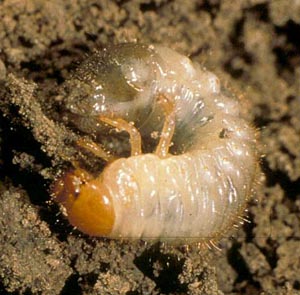White Grubs | |
|---|---|
| August 2, 2007 | |
|
Japanese beetle adult emergences in east-central Illinois continue to be light, but numbers in west-central Illinois are much higher. Southern Illinois is experiencing very high numbers of beetles. Northern Illinois also has large numbers of Japanese beetles. Under these conditions, many turf areas outside of east-central Illinois should be treated with imidacloprid (Merit) or halofenozide (Mach 2). The number of beetles, along with timely rains in east-central Illinois, could support a “wait and see” strategy. Japanese beetles and masked chafer adults are attracted to moist soils and, apparently, to green grass to lay their eggs. In years when rainfall is abundant, nonirrigated (as well as irrigated) turf stays green and attractive to egg-laying female beetles. As a result, eggs are laid over all of these areas, resulting in fewer eggs laid per square foot. The resulting larvae are usually fewer than the 10 to 12 white grubs typically necessary to cause turf injury. In dry years, the beetles are strongly attracted to the moist soils and green grass of irrigated turf to lay their eggs, laying relatively few eggs in the dry, brown, unwatered turf areas. This results in high numbers of white grubs in watered turf, which cause damage in the form of wilted, brown turf that is easily pulled back due to the white grubs’ eating the roots. In much of Illinois, irregular rains have caused many areas of turf that are not irrigated to green up for a few days and then turn brown for a week or so until the next rain. These rains do not appear to be wetting the soil very deeply. As a result, the Japanese beetle and masked chafer adult beetles are probably laying considerably more eggs in irrigated turf. This sets up a situation in which damage is likely to become apparent in the second half of August and later, when the resulting white grubs grow large enough to cause serious turf damage.  White grub larva. Because the eggs laid this month will not all have hatched until the end of the first week of August, decisions concerning preventive treatments of Merit or Mach 2 need to be made based on local rainfall and adult beetle abundance. By about August 10, most of the white grubs should have hatched, allowing scouting to determine for certain whether treatment is necessary. However, both Merit and Mach 2 can take 3 weeks to kill white grubs, allowing the possibility of turf damage to occur before control is achieved. In east-central Illi-nois, the low Japanese beetle flight will probably result in only scattered areas of grub damage; so waiting for the grubs to hatch before determining where to treat is probably the best option. Scout for white grubs by cutting through the turf with a heavy knife. Pull the sod back to reveal the white grubs in the root zone. Check the soil hanging to the turf roots for white grubs, as well as the soil below the roots. Till the upper 2 to 3 inches of soil with your knife to check for white grubs in that region as well. If the soil is dry, till a couple of inches deeper to check for grubs that may have migrated down to moister soil. If at least 10 to 12 grubs per foot square are present, treat with trichlorfon (Dylox) to obtain control in about 3 days. Dylox should not be used unless grubs are present because it is short-lived and is likely to break down after about 5 days. Based on this short longevity, it is recommended that dry soil areas be irrigated a couple of days prior to treatment to bring the grubs up into the root zone where the Dylox can be effective. When using Merit or Dylox, water the application into the soil with at least 1/2 inch of water. Mach 2 is more water soluble; but if at least 1/4 inch of rainfall does not occur within 3 days after application, water it in to avoid breakdown of the insecticide by ultraviolet light from the sun. |